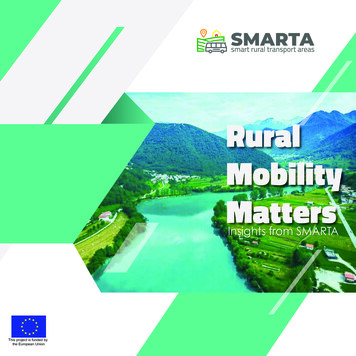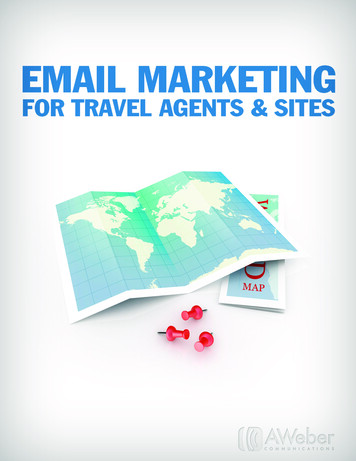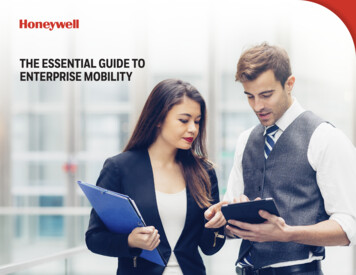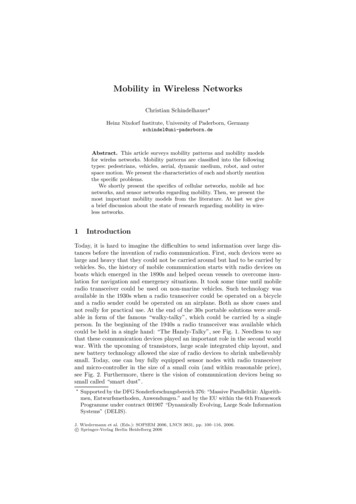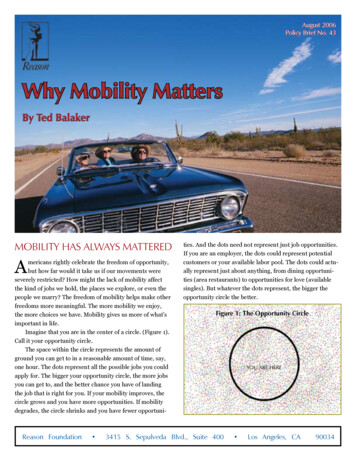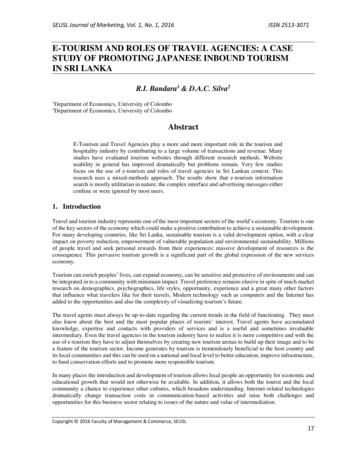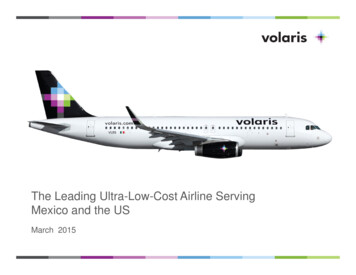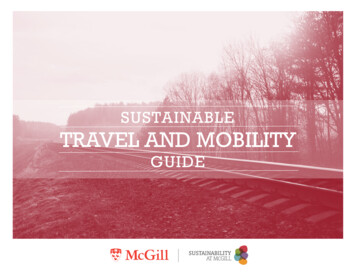
Transcription
SUSTAINABLETRAVEL AND MOBILITYGUIDE
TABLE OF CONTENTSIntroduction3Defining Travel and Mobility4Environmental, Social, andEconomic Impacts of Travel5Best Practice 1: Choose to Travel Less6Best Practice 2: Choose to Travel Sustainably7Local Travel and Mobility7Non-local Travel9Best Practice 3: Choose Accommodations Wisely11Best Practice 4: Support Sustainable Travel Efforts12Appendix: Resources13SUSTAINABLE TRAVEL AND MOBILITY GUIDE2
INTRODUCTIONTravel and mobility play an important role in supporting theUniversity’s mission. They are a means to generate positive impactsand an opportunity to consider and mitigate negative impacts – forour community and for the communities and environments withwhich we engage. Sustainable travel at McGill University refers totravel-related decisions and activities that take full account ofpresent and future environmental, social, and economic impacts inour local and host communities, while supporting the University indelivering its mandate.Becoming a truly sustainable institution relies on the participationand commitment of our entire community, especially when itcomes to individual activities with a high degree of individualchoice, like travel and mobility. The guidance in the SustainableTravel and Mobility Guide, and the many McGill-specific resourcesprovided in the Appendix, will help you to reduce some of thenegative impacts from travel by encouraging you to factorsustainability into your travel decisions.This Guide is best practice for all University travelers – students,faculty, and staff – and applies to travel within and outside ofMontréal. While the guide primarily targets university-relatedtravel, since travel of this type relates directly to McGill’s mission,the guidance provided in the “Local Travel & Mobility” section isuseful for commuters as well.Following several rounds of consultation with students, faculty andstaff, this Guide was developed in tandem by the Office ofSustainability, Procurement Services, and Utilities and EnergyManagement. We appreciate and rely on the commitment of ourcommunity in aligning University-related travel with ourSustainability Policy, Procurement Policy, and Vision 2020Sustainability Strategy.SUSTAINABLE TRAVEL AND MOBILITY GUIDE3
Defining Travel and MobilityAs a research-driven institution with an international population, three campuses in Québec, and numerous research and fieldstations, our community has many reasons to travel. We categorize our travel-related activities into two main types: travel andmobility.University-related Travel refers to travel for universityrelated reasons, and is typically eligible forreimbursement by the University. This includes travel forresearch, fieldwork, conferences, lectures, recruitment,meetings, events, and travel by our varsity sports teams.It consists of transportation arrangements by variousmodes, vehicle rentals, and accommodation.Local Travel and Mobility refers to commuting: theregular (and often daily) movement of our communitymembers between their home and their place of work orstudy, as well as trips between our campuses. Mobility istypically not eligible for reimbursement, while localtravel between campuses can be.SUSTAINABLE TRAVEL AND MOBILITY GUIDE4
Environmental, Social, and Economic Impacts of TravelTraveling sustainably requires one to consider the environmental, social, and economic impacts of our actions. By choosing moresustainable travel and accommodation choices, you can mitigate the negative impacts that your actions and purchases have on localemployment and businesses, as well as cultural and environmental heritage. Of course, traveling more sustainably can also help minimizeemissions to air, water and soil, reduce light and sound pollution, and mitigate detrimental effects on biodiversity.Greenhouse gas (GHG) emissions from travel and mobility – including university-financed air travel, sports team travel, the inter-campusshuttle bus, and commuting – accounted for 26% of McGill’s overall emissions in 2017. As one of the long-term targets in our Vision 2020Climate & Sustainability Action Plan (2017-2020), McGill committed to achieving carbon neutrality by 2040. We know that managing ourtravel footprint and reducing negative impacts from travel will be critical to our success.Scope 3(Travel andMobility)26%Scope 3(other)3%Scope 161%Scope 210%Figure 1. McGill University’s greenhouse gas emissions breakdown by scope 1 and activity for 20171GHG emissions are categorized by scope: Scope 1 (direct emissions), Scope 2 (energy indirect emissions) and Scope 3 (other indirect emissions). An organization has the most ownership and control over Scope 1 and 2 emissions;Scope 3 emissions are also significant due to supply chains, travel, waste, and leased facilities.SUSTAINABLE TRAVEL AND MOBILITY GUIDE5
BEST PRACTICE 1: CHOOSE TO TRAVEL LESSTraveling less is the most effective way to curb our travel footprint and reduce GHG emissions, and will often mean developing alternativeplans, such as leveraging communication technologies. Using and requesting virtual options not only helps reduce our emissions;importantly, doing so also helps improve accessibility for researchers and students with fewer resources around the world by signaling theneed for meeting and event organizers to offer virtual and online platforms. Traveling less, being mindful of the number of travelers, andbundling trips together are cost-effective measures as well.Guidance1.Look for opportunities to avoid University-related travel. Actively identify events where you could benefit from the activityusing virtual and online means of attendance and communication.2.Make use of online programming and technologies. Conferences and events often host at least some programming online.Contact event organizers to inquire about virtual options. Video-conferencing and other tools can help replace a portion ofmeetings and other events requiring travel.3.Consider how many people need to attend the event. Reducing the number of people who are traveling can often reduce thetravel footprint, especially for air travel. If fewer people are attending, create processes to share knowledge and research.4.Combine multiple trips. If you often travel between the same locations, or have events and meetings in the same region, takeaction in advance and plan to combine trips, especially for air travel.5.Collaborate with local networks. Consider “hub-and-node” event design – local events held in tandem with a larger central event– and reach out to your local networks.SUSTAINABLE TRAVEL AND MOBILITY GUIDE6
BEST PRACTICE 2: CHOOSE TO TRAVEL SUSTAINABLYIf you decide to travel, you can reduce your travel footprint by choosing the most sustainable mode and route (itinerary) for the distanceand number of travelers. While certainly not the only sustainability consideration, greenhouse gas emissions are one way to compare thesustainability of different travel modes because they are linked to fuel consumption and combustion technology. Modes with a lowercarbon footprint are often more cost-efficient and accessible as well.The emissions associated with different forms of transport depend on many factors including fuel type, vehicle model and age, technology,class of travel, passenger load, local energy grids, and distance travelled. Average “carbon intensity” factors, calculated as tonnes of carbondioxide equivalent2 per passenger kilometer (tCO2e/pass-km), are available and provide a useful comparison when planning a trip anddeciding on travel mode – refer to Figures 2, 3, and 4.LOCAL TRAVEL AND MOBILITYActive transit (e.g. walk bike)Local travel and mobility within Montréal and southern Québec includescommuting to and from our campuses, travel between our campusesand affiliate locations, fieldwork, sports teams travel, meetings, andcollaborating with other Montréal-based institutions; it does not includeair travel, which is not generally a sustainable option for local trips. Thisguidance also applies to travelling locally once you have reached a nonlocal destination.STM transit (e.g. bus metro)Intercity rail (e.g. VIA)Gas car (2 people)Gas car (1 person)0.000.050.100.150.20Figure 2. Comparison of Montreal-Specific Local Travel Modes3 (kgCO2e/passenger-km)2Carbon dioxide equivalent is used to convert the global warming potential of the Kyoto Protocol GHGs – carbon dioxide, methane, nitrous oxide, hydrofluorocarbons, perfluorocarbons, sulphur hexafluoride, and nitrogentrifluoride – into a common unit.3Emission factors sourced from Environment Canada’s National Inventory Report (2017), the Office of Energy Efficiency (2017), STM’s Rapport de developpement durable (2017), and the US Environmental Protection Agency’sGHG Emission Factors Hub (2015).SUSTAINABLE TRAVEL AND MOBILITY GUIDE7
Guidance1.Whenever possible, prioritize active transit4. Active transit is the most sustainable form of transportation from anenvironmental, social and economic perspective: reduced fuel consumption, greenhouse gas emissions, air pollution and roadcongestion, improved health through physical activity, and more affordable and accessible for individuals.2.Where active transit is not an option, choose public transit5 over private vehicle journeys. McGill offers an inter-campus shuttlebus between the downtown and Macdonald campuses. Sociétéde transport de Montréal (STM) coverage is extensive, andparatransit service is offered to those with accessibility needs.3.If journeys require private vehicles, reduce single-occupantvehicle journeys and maximize carpooling. Fewer vehicles withmore passengers lowers the carbon intensity of travelsignificantly while also reducing congestion, noise and airpollution.4.If renting or choosing between vehicles, prioritize fuel efficientand alternative fuel models, such as electric and hybrid vehiclesor top-performing vehicles for fuel efficiency. There are electricvehicle charging stations located in the Bronfman and McIntyre garages downtown and at the Macdonald and Gault campuses.5.Help facilitate active and public transit. Be understanding of the time required to travel to meetings or events using theseoptions, ensure reimbursements for public transit are provided, and help raise awareness and provide resources.4Active transit refers to “human-powered transit” and includes activities like walking, cycling, using a wheelchair, rollerblading, skiing, and skateboarding.Local public transit options include buses, light rail and rapid transit (e.g. trams and subways), commuter and national rail, and ferries. Fortunately, Montréal’s transit system has wide coverage, including a specific airport busroute, and is more affordable than other similarly sized Canadian cities.5SUSTAINABLE TRAVEL AND MOBILITY GUIDE8
NON-LOCAL TRAVELUniversity-related travel to northern and western Canada and international destinations often requires air travel. The emissions generatedfrom one traveler’s return flight in business class between Montréal and Tokyo are 4.79 tCO 2e6. Compared to the global average annualemissions per capita in 2014, which were 6.29 tCO2e7, this single return flight accounts for 76% of this amount. It is clear that reducing airtravel, and making sustainable decisions when we do fly, i.e., choosing economy class, is critical to our efforts to become a more sustainableinstitution.Intercity railGas car (2 people)Flight, long-haul, average classFlight, short-haul, average class0.00 0.02 0.04 0.06 0.08 0.10 0.12 0.14 0.16Figure 3. Comparison of Average North American Non-local Travel Modes8 (KgCO2e/km)Flight, long-haul, first classFlight, long-haul, business classFlight, long-haul, economy classFlight, medium-haul, business classFlight, medium-haul, economy classFlight, short-haul, all classes0.000.050.100.150.200.250.300.35Figure 4. Comparison of Flight Classes for Air Travel (KgCO 2e/passenger-km)6Conversion factors 2018. Department for Business, Energy & Industrial Strategy (BEIS). Available online: use-gas-reporting-conversion-factors-2018.CAIT Climate Data Explorer. Total GHG Emissions excluding land-use change and forestry per capita, 2014. http://cait.wri.org/historical/.8Emission factors sourced from the UK’s Department for Business, Energy & Industrial Strategy’s 2018 conversion factors (2018), Environment Canada’s National Inventory Report (2017), the Office of Energy Efficiency (2017)and the US Environmental Protection Agency’s GHG Emission Factors Hub (2015).7SUSTAINABLE TRAVEL AND MOBILITY GUIDE9
Guidance91.Prioritize rail over air travel for shorter trips. The carbon intensity of short-haul air travel ( 490 miles) is disproportionately higher becausea greater portion of emissions are generated during the take-off and landing cycle. Rail travel is an excellent option, especially within Europe,Japan, and eastern North America.2.Choose car travel over air travel when traveling with a group. Renting one or more vehicles and maximizing the occupancy of each,especially if you choose alternative fuel or fuel-efficient options, reduces fuel consumption and GHGs per traveler significantly compared toair travel.3.Choose economy class. Business and first class seats offer more space and services, which translates into a greater share of weight perpassenger and, consequently, increased fuel consumption and emissions. Booking seats in a fare class greater than economy (or lowestlogical airfare) requires the prior approval of the Dean or Vice Principal/Provost 9.4.Fly direct. As mentioned above, take-off and landing cycles contribute heavily to flight emissions, so choosing direct flights or a route withfewer connections is often more sustainable. Also, direct flights mean less distance traveled.5.Use public transit for travel to and from transport hubs. Taxis and private vehicles are often used for travel to and from airports and trainstations, but many cities offer affordable and efficient public transit designed for airport service.6.Fill out expense reports in a bit more detail. To calculate the University’s annual emissions, we currently rely on expense reports for airtravel data. Take a few moments to fill these out clearly, especially for trips with flights. Include all destinations visited for multi-leg journeysin the “Destination” field, and indicate the airport as well (e.g. “Montréal to NYC (JFK) to Santiago (SCL) to Los Angeles (LAX) to Montréal(YUL)”).7.Consider purchasing third party offsets. Choose carbon offset10 projects that are certified (e.g. Gold Standard) by a reputable third party,demonstrate proven additionality and permanence, and have systems in place to reduce leakage.From McGill’s Procedures for Travel and Other Reimbursable ExpensesA carbon offset, measured in tCO2e, is a credit for emissions reductions achieved by one party that another party can purchase and use to compensate – or “offset” – their GHG emissions.10SUSTAINABLE TRAVEL AND MOBILITY GUIDE10
BEST PRACTICE 3: CHOOSE ACCOMODATIONS WISELYAccommodation services generate multiple social, environmental and economic impacts. The provision of clean and comfortable spaces requiresenergy, clean water, food and other services that provide local employment but also generate impacts on local resources: water (from wastewater andpollution), air (from solvents, aerosols, detergents, vehicle emissions and heating/cooling), soil (from waste management), and even in some caseschanges in land use and the affordability of local housing. Research and favour more sustainable accommodation.Guidance1.Look for more sustainable lodging options. Some hotels and guesthouses take tangible steps to reduce their environmental impacts.Research carefully, and refer to credible sustainability ranking and certification schemes where available (see Appendix for examples).2.Inquire about their commitment to sustainability. If a trusted certification or ranking is not available, make inquiries. Do they have apolicy or strategy for addressing social, environmental, and economic criteria? Have they implemented any sustainability initiatives? Beaware of greenwashing and marketing gimmicks.3.Choose accommodation that reduces daily travel. Ifpossible, choose lodging in a neighbourhood that willallow you to use active or public transit to get to eventsand meetings.4.Be a conscientious visitor. You can take small actions toreduce the impact of your stay. Turn off lights and A/Cwhen you’re not in the room, opt out of having your linensand towels changed daily, make use of low-flowshowerheads where available, bring your own toiletries tomitigate single-use plastics, and unplug small appliancesand electronics you don’t plan on using. If you are soinclined, take time to learn about the local history andculture and enjoy locally produced food, too.SUSTAINABLE TRAVEL AND MOBILITY GUIDE11
BEST PRACTICE 4: SUPPORT SUSTAINABLE TRAVEL EFFORTSThe following steps help build a culture of sustainable travel at the University and improve the accuracy of our own travel data, which we rely on forannual GHG inventory reports, tracking and communicating progress, and external data reporting like AASHE’s STARS 11 program.1.Spread the word. Lead conversations about sustainable travel habits in your unit. Let others know about McGill’s sustainability strategyand carbon neutrality target, and share these Guidelines with them.2.Plan sustainable events that factor in travel considerations. If you are planning an event, make use of McGill Sustainable Events’ guidance(there is a section specific to travel) and consider getting your event certified.3.Work with your team towards a Sustainable Workplace Certification. With increasing levels of ambition from Bronze to Platinumcertification, the Office of Sustainability’s workplace program addresses travel. The Silver level features actions related tovideoconferencing and strategic meeting planning to maximize active and public transit, while the Platinum level promotes active andpublic transit for mobility and encourages the purchase of offsets to compensate for air travel emissions.4.Engage with Transportation Research at McGill (TRAM). The TRAM research group, a multidisciplinary team in the School of UrbanPlanning, conducts diverse research on transportation systems, active transit, and travel behaviour. They also collect and analyze data onthe travel and commuting habits of the McGill community – take advantage of the opportunity to provide feedback if you receive thesurvey, and check out past results on their website.5.Set specific travel guidelines or targets for your team. These Guidelines provide strategic advice for all travelers in the McGillcommunity. Your own team may have insights and ideas for travel specific to your unit.11McGill reports to the Association for the Advancement of Sustainability in Higher Education’s (AASHE) Sustainability Tracking, Assessment & Rating System (STARS) and has set a long-term target of achieving a Platinum STARSrating by 2030.SUSTAINABLE TRAVEL AND MOBILITY GUIDE12
APPENDIX: RESOURCESBEST PRACTICE 1: CHOOSE TO TRAVEL LESS The University IT Knowledge Base lists publicly available video-conferencing facilities.Teaching & Learning Services offers the MS-74 innovative classroom space featuring a range of technologies – including videoconferencing with external participants.Other video-conferencing facilities may exist within your department or faculty and be available upon request.The IT Knowledge Base provides instructions for using the existing Skype for Business and Adobe Connect platforms.Share knowledge and resources in a shared online hub like OneDrive, Documentum D2 and Yammer.BEST PRACTICE 2: CHOOSE TO TRAVEL SUSTAINABLYLocal Travel Use this map of bicycle racks near the downtown campus to help plan your trip.McGill offers a discounted annual membership to the BIXI bike-share program and there are stations all around the downtown campus.A small self-serve bike fleet is available for loan – free of charge – at Laird Hall on the Macdonald Campus to folks with a valid University ID.The FLAT Bike Collective, run by student volunteers, offers the space, tools and know-how to teach you how to repair your bike – free ofcharge.McGill’s adapted transport service is free to students & staff with mobility impairments.Visit the STM website for information about their paratransit program.Refer to the University’s campus access guides to familiarize yourself with the accessibility of different buildings.Our inter-campus shuttle bus provides free transportation between the downtown and Macdonald campuses, and the bus featuresequipment to transport two bicycles.Compare the fuel efficiency of vehicles using Natural Resources Canada’s fuel consumption ratings tool and factor this into vehicle rentaldecisions. One rule of thumb is to select the smallest vehicle appropriate for the intended use and group size.Travel Services provides resources for booking rental cars within and outside of Canada.The 747 bus provides easy access between downtown and the P.-E. Trudeau airport.Visit Parking and Transportation Services’ Transport website for a wealth of information on how to get to, from, and around our campuses.SUSTAINABLE TRAVEL AND MOBILITY GUIDE13
Non-local Travel McGill offers a discounted rate for VIA Rail to students traveling for University-related purposes, and to faculty and staff for any travel forthemselves and up to three people.Compare the fuel efficiency of vehicles using Natural Resources Canada’s fuel consumption ratings tool and factor this into vehicle rentaldecisions.Consider booking air travel through Vision Travel for discounted airfare. Data for flights booked via the Platform is accurate and helpssupport our GHG inventories, and allows us to gather data on travel needs towards optimizing pricing. In addition, when booking viaVision, travelers can view and compare GHG emissions for different flight options.Roughly compare the travel time and emissions of planes, trains and automobiles for several popular VIA Rail routes.For information on reputable third-party carbon offset providers, please contact the McGill Office of Sustainability.Visit McGill Travel Services’ website for more helpful information.BEST PRACTICE 3: CHOOSE ACCOMODATIONS WISELY McGill’s Travel Services has negotiated special arrangements with hotels near the downtown and Macdonald campuses – including manywithin walking distance. There are also reduced rates available for hotels throughout Quebec.Check out the rating of your accommodation options under the following programs: Green Key Global Green Globe Trip Advisor’s Green LeadersUniversity staff can take advantage of preferential hotel rates in Canada through the Canadian Association of University Business Officers(CAUBO).SUSTAINABLE TRAVEL AND MOBILITY GUIDE14
Travel and Mobility Guide, and the many McGill-specific resources provided in the Appendix, will help you to reduce some of the negative impacts from travel by encouraging you to factor sustainability into your travel


